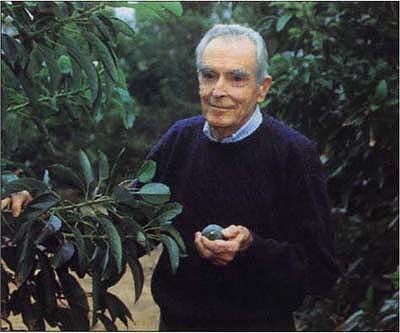All Issues
Q & A: George Zentmyer, Plant Pathologist
Publication Information
California Agriculture 50(6):38-38.
Published November 01, 1996
PDF | Citation | Permissions
Abstract
George Zentmyer, professor emeritus of plant pathology at UC Riverside, received his Ph.D. in plant pathology from UC Berkeley in 1938 and joined UC's Citrus Experiment Station in 1944 as a plant pathologist. Zentmyer, a member of the prestigious National Academy of Sciences, is a leading authority on plant diseases caused by the fungus Phytophthora, particularly Phytophthora cinnamomi, which causes severe root rot of avocado trees. His work has focused on root diseases, soil fungicides, biological control of soil pathogens and diseases of avocado trees and other subtropical and tropical crops. The studies have provided a multifaceted approach to control plant diseases that threaten the multimillion dollar avocado industry.
Full text
You arrived in Riverside two years prior to the first issue of California Agriculture. What brought you to Riverside?
GZ: I came to Riverside because one of the early plant pathologists here, Prof. William Horne, passed away in 1943 and there was a search initiated to find someone to take his place.
The Citrus Experiment Station was really beginning to expand and there was even more expansion in the 1950s and 1960s. We were looking at an array of subtropical and tropical crops including avocado — fruits like macadamia, cacao, persimmon, and jojoba, especially tree fruits and ornamental crops in Southern California that became extensive industries. There was also a great expansion in citrus research. Research was just beginning on a new disease, tristeza, known as “quick decline.” It posed a tremendous threat to the entire citrus industry, not only here, but around the world. The horticulturists, entomologists and plant pathologists did not know until the early 1950s what was causing this disease. When they found out it was a virus, the research to find a control fell largely to our department, plant pathology. We found some rootstocks were resistant, so there was a big expansion in rootstock research. There were also quite a few insects that the entomologists under Al Boyce were working on. It was quite a growth period under Dr. Boyce from 1952 up through the 1970s.
When you arrived in 1944, how did you perceive your role?
GZ: The one major avocado disease, Phytophthora root rot, was just appearing then and it became a monstrous problem for the industry. In fact, the cause of it had just been discovered about two years before I came, a soil fungus called Phytophthora cinnamomi. The big push in avocado disease research was to find out what was causing this disease, to find out what factors influenced it, how the fungus survived in the soil and if we could find resistance and other means of control. What became a large part of my research for the next 40 years was collecting avocado rootstock materials in Central and South America. I explored 17 or 18 countries in Latin American looking for sources of resistance in the many native avocados and relatives that grow in that region.
There were some soil fungicides that were available at that time. We experimented with those and set up many field plots around San Diego, Santa Barbara, Ventura and Los Angeles counties to try and control this disease by application of fungicides in the irrigation water. There were a few that showed some promise but nothing spectacular. We also did work on soil fumigants. That's when I began to research resistant types of avocado. We had a few indications, even with some of our collections from Mexico, Guatemala and Central America, that there was rootstock resistance. We pursued that extensively in the next 20 to 30 years. In fact, several of our selections have shown substantial resistance and several of these are now produced by the nurserymen in California and various countries routinely as their preferred rootstock for planting in infested soil.
This disease is still a problem around the world. You can fumigate it in local spots and replant the tree successfully, but the fungus is so successfull, it survives in soil that has not been planted for years.
Looking back at your half-century association with the University of California, what would you say are the University's most significant research and extension activities?
GZ: Very remarkable was the solving of the tristeza problems in citrus back in the 1950s, determining this was caused by a virus, and finding rootstock with resistance and being able to control the spread of the disease. That disease decimated citrus not only in California, but in Brazil — one of the original sources of our citrus varieties. In relation to avocado, the development of the new resistant rootstocks has helped to solve that huge avocade root rot problem, not only here, but in places like Israel, Australia and South Africa. There have been new irrigation methods, including the development of drip irrigation in the 1960s and 1970s. Really, there are just too many to name. There has been a very wide variety of problems the University has been able to address and solve.





